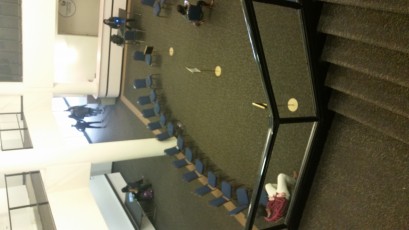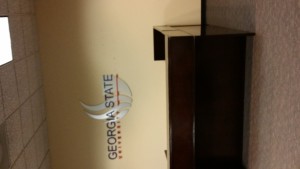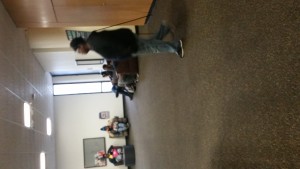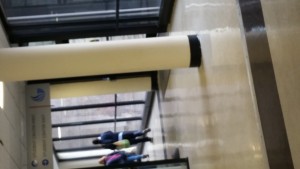Tapestry of Space
Margaret Morton’s pictures of the homeless in New York show how urban spaces can impact behavior. The first book, The Tunnel, was published in 1995 and the second book, Fragile Dwelling, was published in 2000. These two books pair photographs and stories of the homeless and their use of discarded items to make themselves a place to live. “The underground and above ground homes are designed by taking material fragments and lining up the pieces in a cohesive manner that corresponds to the splintered identity’s attempt to conform to the notion of a unified and solid self.”, this use of space to represent one’s self show how, like a home owner, they’re tied to the spaces where they live. A person’s house is a reflection of their personality and identity. These homeless people are not truly homeless, it would be more accurate to say they lack the presents of a stable home.
To understand Morton you need to apply twentieth century Marxist ideas about society. The term “spectacle” is used to show how society is depend on the use of media and images, and a society like this the individual understands themselves by the means of mass media. The society is shown something and then they want to gain that object or status. The people have been turned into a society that is controlled by whatever is shown to them, and the people themselves can no longer experience reality. The people had become controlled by the system and turned into whatever the leaders wanted, slowly making the people who lived there struggle more.
Many of Morton’s interviewed stayed in the tunnels, but some left to again see the outside world. Many of the ways into the tunnels had been blocked off or sealed to stop people from living there. Many of the homeless had been told they were trespassing and would need to leave and would be arrested, but they had no where else to go, so they stayed. The homeless has committed a criminal offence by being homeless and having no where to go. This pushing people out of the public spaces of the tunnels is just another way of controlling the public spaces.
The people of the tunnel have homes, which they built. The ideal that these people don’t have homes because they don’t own where they lived can be dismissed when you realized that many people don’t own the houses they live in. The difference between the homeless and those who have homes is different levels of vulnerability. People who are homeless know how vulnerable they are, but people who do have homes hide how vulnerable they are by blinding themselves with material things. The homeless struggle to find places in busy cities that are not being utilized by the cities population. To gives these people the right to house would give the right to house and the ability to removes these damaging stereotypes that depict them as lazy. There survival isn’t based on their ability to beg, but it is based on their ability to garden take care of animals, because they end up being more thoughtful and caring the land around them and the space they live.
Architectural Exclusion
Wealthy, mostly white residents of more Northern Atlanta have spoke out and opposed the expansion of the MARTA to keep poorer people and minorities out of their neighborhoods and jobs. In 1974 the city of Memphis closed a road connecting a mostly white neighborhood and a mostly bad neighborhood. The people in favor of this notion claimed it would help noise and safety. The notion was challenged, but any opposition to this notion was ignored. This action carried a strong message of discrimination, but that was some how not noticed by people who make sure things are not discriminatory.
This Article mainly focuses the discriminatory treatment of those who are exulted by how city are built more to cater to the rich and hide away the poorer citizens. The first part of this article focuses on how the built environment changes and shapes the behavior of those who live in them. This power to decide how people will act in area should give law-markers and people of power the ability to control everything, but they often ignore the impacts that some actions have on some areas.
All through history city builders and architects have used many different ways to keep people who are not wanted in an area out. Methods of law and violence are not looked highly upon when separating people, but the use of barriers such as walls and buildings is ignored and not looked down upon. We don’t really pay much attention to why things are built how they are or who they restrict. If you saw a bench with a bar in the middle you might thing it was made to have two arm rests, but sometimes things are cleverly hidden and what looked innocent is like that to keep the homeless from using it as a place to sleep. Sometimes things like this are done with some different idea that isn’t intended to restrict people, but end up doing it because of how something is designed.
The ability to control how a city is built can be good or bad. In the hands of somebody who is rich and wants to hide away minorities and the poor will you tactics like large buildings and walls around their neighborhoods to restrict their ability to move around and be seen. This is like a cafeteria who wants to promote healthy food choices by hiding and making it harder to reach junk food or poor health choices. This power to change how a city is laid out is a way of controlling people and regulating them.
Legal academics have come up with the notion that some places have racial meanings. “Elise C. Boddie argues that places have racial identities based on their history of or reputation for exclusion, and that courts should consider this racial meaning for purposes of racial discrimination claims.” These racial meaning let people like police officers keep tabs on minorities and keep some races and people away from things like parks. A leading land-use book has a chapter on tools of exclusion such as racially restrictive covenants and exclusionary zoning, but done not talk about exclusion based on features of the built environment.
Hello world!
Welcome to your brand new blog at sites@gsu.edu!
To get started, edit or delete this post and check out all the other options available to you.
For assistance, visit the comprehensive support site, check out the Edublogs User Guide guide or stop by The Edublogs Forums to chat with other edubloggers.
For personal support, you can attend Georgia State’s training on Edublogs or stop by The Exchange for one-on-one support.
You can also reference the free publication, The Edublogger, which is jammed with helpful tips, ideas and more.



